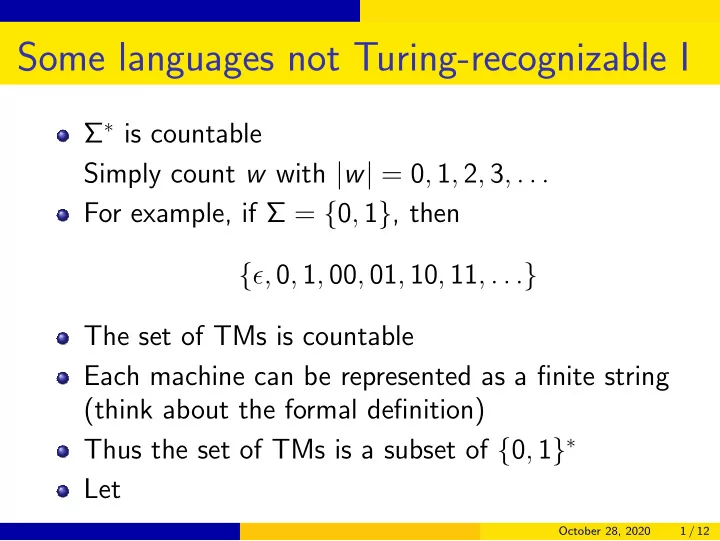

Some languages not Turing-recognizable I Σ ∗ is countable Simply count w with | w | = 0 , 1 , 2 , 3 , . . . For example, if Σ = { 0 , 1 } , then { ǫ, 0 , 1 , 00 , 01 , 10 , 11 , . . . } The set of TMs is countable Each machine can be represented as a finite string (think about the formal definition) Thus the set of TMs is a subset of { 0 , 1 } ∗ Let October 28, 2020 1 / 12
Some languages not Turing-recognizable II L : all languages over Σ B : all infinite binary sequences For any A ∈ L there is a corresponding element in B Example: A : 0 { 0 , 1 } ∗ Σ ∗ = { ǫ, 0 , 1 , 00 , 01 , 10 , 11 , 000 , 001 , . . . } A = { 0 , 00 , 01 , 000 , 001 , . . . } χ A = 010110011 . . . October 28, 2020 2 / 12
Some languages not Turing-recognizable III One-to-one correspondence between B and L B is uncountable (like real numbers) Therefore, L is uncountable Each TM ⇒ handles one language in L Set of TM is countable, but L is not Thus some languages cannot be handled by TM October 28, 2020 3 / 12
Halting problem undecidable I Recall the halting problem is A TM = {� M , w � | M : TM, accepts w } We prove it is undecidable by contradiction Assume there is an H that is a decider for A TM Then H satisfies � accept if M accepts w H ( � M , w � ) = reject otherwise Construct a new TM D with H as a subroutine October 28, 2020 4 / 12
Halting problem undecidable II For D , the input is � M � , where M is a TM It runs H on � M , � M �� and outputs the opposite result of H The machine D satisfies � accept if M rejects � M � D ( � M � ) = reject if M accepts � M � But we get a contradiction � accept if D rejects � D � D ( � D � ) = reject if D accepts � D � October 28, 2020 5 / 12
Halting problem undecidable III We said earlier that the diagonalization method is used for the proof. Is that the case? We show that indeed it is used October 28, 2020 6 / 12
Diagonalization in the proof I Set of TMs is countable so we can have � M 1 � � M 2 � � M 3 � A A M 1 A A A M 2 . . . blank entries: unknown if reject or loop But H knows the solution as it is a decider � M 1 � � M 2 � � M 3 � A R A M 1 A A A M 2 . . . October 28, 2020 7 / 12
Diagonalization in the proof II D outputs opposite of diagonal entries � M 1 � � M 2 � . . . � D � R M 1 R M 2 ... ? D October 28, 2020 8 / 12
co-Turing-recognizable Language I Definition: a language is co-Turing-recognizable if its complement is Turing-recognizable Theorem 4.22 Decidable ⇔ Turing-recognizable and co-Turing-recognizable Why not Turing-recognizable ⇒ complement Turing-recognizable Note that “recognizable” means any October 28, 2020 9 / 12
co-Turing-recognizable Language II w ∈ language is accepted by the machine in a finite number of steps That is, no infinite loop Example: A TM Turing-recognizable but not decidable w ∈ A TM ⇒ reject or loop Thus A TM is not Turing-recognizable October 28, 2020 10 / 12
co-Turing-recognizable Language III What if we swap q accept , q reject ? If a / ∈ A and loop occurs then a ∈ A , but TM still loops We cannot reach the new q accept state Proof of Theorem 4.22 “ ⇒ ” Decidable ⇒ Turing-recognizable Complement ⇒ decidable ⇒ Turing-recognizable October 28, 2020 11 / 12
co-Turing-recognizable Language IV “ ⇐ ” Now A , A are Turing-recognizable by two machines M 1 , M 2 Construct a new machine M : for any input w Run M 1 , M 2 in parallel 1 M 1 accept ⇒ accept, M 2 accept ⇒ reject 2 Never infinity loop M accepts all strings in A , reject all not in A Thus A is decidable with a decider M October 28, 2020 12 / 12
Recommend
More recommend